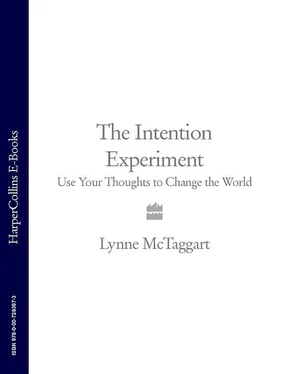Most of his colleagues in condensed-matter physics remained interested in symmetrical systems such as crystalline solids, whose atoms are arranged in orderly array, like eggs in a carton, but Rosenbaum was drawn to strange systems that were inherently disordered – to which more conventional quantum physicists referred disparagingly as ‘dirt’. In dirt, he believed, lay exposed the unprobed secrets of the quantum universe, uncharted territory that he was happy to navigate. He loved the challenge posed by spin glasses, strange hybrids of crystals, with magnetic properties, technically considered slow-moving liquids. Unlike a crystal, whose atoms point in the same direction in perfect alignment, the tiny magnets associated with the atoms of a spin glass are wayward and frozen in disarray.
The use of extreme coldness allowed Rosenbaum to slow down the atoms of these strange compounds enough to observe them minutely, and to tease out their quantum mechanical essence. At temperatures near to absolute zero, when their atoms are nearly stationary, they begin taking on new collective properties. Rosenbaum was fascinated by the recent discovery that systems disorderly at room temperature display a conformist streak once they are cooled down. For once, these delinquent atoms begin to act in concert.
Examining how molecules behave as a group in various circumstances is highly instructive about the essential nature of matter. In my own journey of discovery, Rosenbaum’s laboratory seemed the most appropriate place to begin. There, at those lowest temperatures where everything occurs in slow motion, the true nature of the most basic constituents of the universe might be revealed. I was looking for evidence of ways in which the components of our physical universe, which we think of as fully realized, are capable of being fundamentally altered. I also wondered whether it could be shown that quantum behaviour like the observer effect occurs outside the subatomic world, in the world of the everyday. What Rosenbaum had discovered in his refrigerator might offer some vital clues as to how every object or organism in the physical world, which classical physics depicts as an irreversible fact, a finalized assemblage only changeable by the brute force of Newtonian physics, could be affected and ultimately altered by the energy of a thought.
According to the second law of thermodynamics, all physical processes in the universe can only flow from a state of greater to lesser energy. We throw a stone into a river and the ripple it makes eventually stops. A cup of hot coffee left standing can only grow cold. Things inevitably fall apart; everything travels in a single direction, from order to disorder.
But this might not always be inevitable, Rosenbaum believed. Recent discoveries about disordered systems suggested that certain materials, under certain circumstances, might counteract the laws of entropy and come together rather than fall apart. Was it possible that matter could go in the opposite direction, from disorder to greater order?
For ten years Rosenbaum and his students at the James Franck Institute had been asking that question of a small chunk of lithium holmium fluoride salt. Inside Rosenbaum’s refrigerator lay a perfect chip of rose-coloured crystal, no bigger than the head of a pencil, wrapped in two sets of copper coils. Over the years, after many experiments with spin glasses, Rosenbaum had grown very fond of these dazzling little specimens, one of the most naturally magnetic substances on earth. This characteristic presented the perfect situation in which to study disorder, but only after he had altered the crystal beyond recognition into a disordered substance.
He had first instructed the laboratory that grew the crystals to combine the holmium with fluorine and lithium, the first metal on the periodic table. The resulting lithium holmium fluoride salt was compliant and predictable – a highly ordered substance whose atoms behaved like a sea of microscopic compasses all pointing north. Rosenbaum then had wreaked havoc on the original salt compound, instructing the lab to rip out a number of the atoms of holmium, bit by bit, and replace them with yttrium, a silvery metal without such natural magnetic attraction, until he was left with a strange hybrid of a compound: a salt called lithium holmium yttrium tetrafluoride.
By virtually eliminating the magnetic properties of the compound, Rosenbaum eventually had created spin-glass anarchy – the atoms of this Frankenstein monstrosity pointing any way they liked. Being able to manipulate the essential property of elements like holmium by creating weird new compounds so cavalierly was a little like having ultimate control over matter itself. With these new spin-glass compounds, Rosenbaum could virtually change the properties of the compound at will; he could make the atoms orientate in a particular direction, or freeze them in some random pattern.
Nevertheless, his omnipotence had a limit. Rosenbaum’s holmium compounds behaved themselves in some regards, but not in others. One thing he could not do was to get them to obey the laws of temperature. No matter how cold Rosenbaum made his refrigerator, the atoms inside them resisted any sort of ordered orientation, like an army refusing to march in step. If Rosenbaum was playing God with his spin glasses, the crystal was Adam, stubbornly refusing to obey His most fundamental law.
Sharing Rosenbaum’s curiosity about the strange property of the crystal compound was a young student called Sayantani Ghosh, one of his star PhD candidates. Sai, as her friends called her, a native of India, had graduated with a first-class honours degree from Cambridge, after which she had chosen Tom’s lab for her doctoral programme in 1999. Almost immediately, she had distinguished herself by winning the Gregor Wentzel Prize, given each year by the University of Chicago’s physics department to the best first-year graduate student teaching assistant. The slight 23-year-old, who at first glance appeared abashed, hiding behind her copious dark hair, had soon impressed her peers and teachers alike with her bold authority, a rarity among science students, and her ability to translate complex ideas to the level an undergraduate could comprehend. Sai shared the distinction of winning the coveted prize with only one other woman since its inception 25 years before.
According to the laws of classical physics, applying a magnetic field will disrupt the magnetic alignment of a substance’s atoms. The degree to which this happens is the salt’s ‘magnetic susceptibility’. The usual pattern with a disordered substance is that it will respond to the magnetic field for a time and then plateau and tail off, as the temperature drops or the magnetic field reaches a point of magnetic saturation. The atoms will no longer be able to flip in the same direction as that of the magnetic field and so will begin to slow down.
In Sai’s first experiments, the atoms in the lithium holmium yttrium salt, as predicted, grew wildly excited with the application of the magnetic field. But then, as Sai increased the field, something strange began to happen. The more she turned up the frequency, the faster the atoms continued to flip over. What is more, all the atoms, which had been in a state of disarray, began pointing in the same direction and operating as a collective whole. Then, small clusters of about 260 atoms aligned, forming ‘oscillators’, spinning collectively in one direction or another. No matter how strong the magnetic field that Sai applied, the atoms remained stubbornly aligned with each other, acting in concert. This self-organization persisted for 10 seconds.
At first, Sai and Rosenbaum thought these effects might have something to do with the strange effects of the remaining atoms of holmium, known to be one of the very few substances in the world with such long-range internal forces that in some quarters it was described and worked out mathematically as something existing in another dimension. 2Although they didn’t understand the phenomenon they had observed, they wrote up their results, which were published in the journal Science in 2002. 3
Читать дальше











